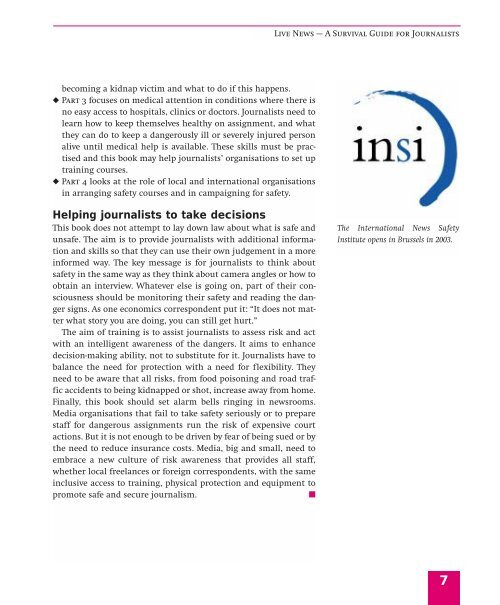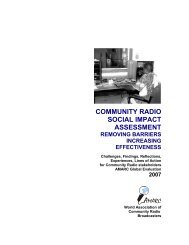Live News - A Survival Guide - International Federation of Journalists
Live News - A Survival Guide - International Federation of Journalists
Live News - A Survival Guide - International Federation of Journalists
- No tags were found...
You also want an ePaper? Increase the reach of your titles
YUMPU automatically turns print PDFs into web optimized ePapers that Google loves.
<strong>Live</strong> <strong>News</strong> — A <strong>Survival</strong> <strong>Guide</strong> for <strong>Journalists</strong>becoming a kidnap victim and what to do if this happens.◆ Part 3 focuses on medical attention in conditions where there isno easy access to hospitals, clinics or doctors. <strong>Journalists</strong> need tolearn how to keep themselves healthy on assignment, and whatthey can do to keep a dangerously ill or severely injured personalive until medical help is available. These skills must be practisedand this book may help journalists’ organisations to set uptraining courses.◆ Part 4 looks at the role <strong>of</strong> local and international organisationsin arranging safety courses and in campaigning for safety.Helping journalists to take decisionsThis book does not attempt to lay down law about what is safe andunsafe. The aim is to provide journalists with additional informationand skills so that they can use their own judgement in a moreinformed way. The key message is for journalists to think aboutsafety in the same way as they think about camera angles or how toobtain an interview. Whatever else is going on, part <strong>of</strong> their consciousnessshould be monitoring their safety and reading the dangersigns. As one economics correspondent put it: “It does not matterwhat story you are doing, you can still get hurt.”The aim <strong>of</strong> training is to assist journalists to assess risk and actwith an intelligent awareness <strong>of</strong> the dangers. It aims to enhancedecision-making ability, not to substitute for it. <strong>Journalists</strong> have tobalance the need for protection with a need for flexibility. Theyneed to be aware that all risks, from food poisoning and road trafficaccidents to being kidnapped or shot, increase away from home.Finally, this book should set alarm bells ringing in newsrooms.Media organisations that fail to take safety seriously or to preparestaff for dangerous assignments run the risk <strong>of</strong> expensive courtactions. But it is not enough to be driven by fear <strong>of</strong> being sued or bythe need to reduce insurance costs. Media, big and small, need toembrace a new culture <strong>of</strong> risk awareness that provides all staff,whether local freelances or foreign correspondents, with the sameinclusive access to training, physical protection and equipment topromote safe and secure journalism.■The <strong>International</strong> <strong>News</strong> SafetyInstitute opens in Brussels in 2003.7
















